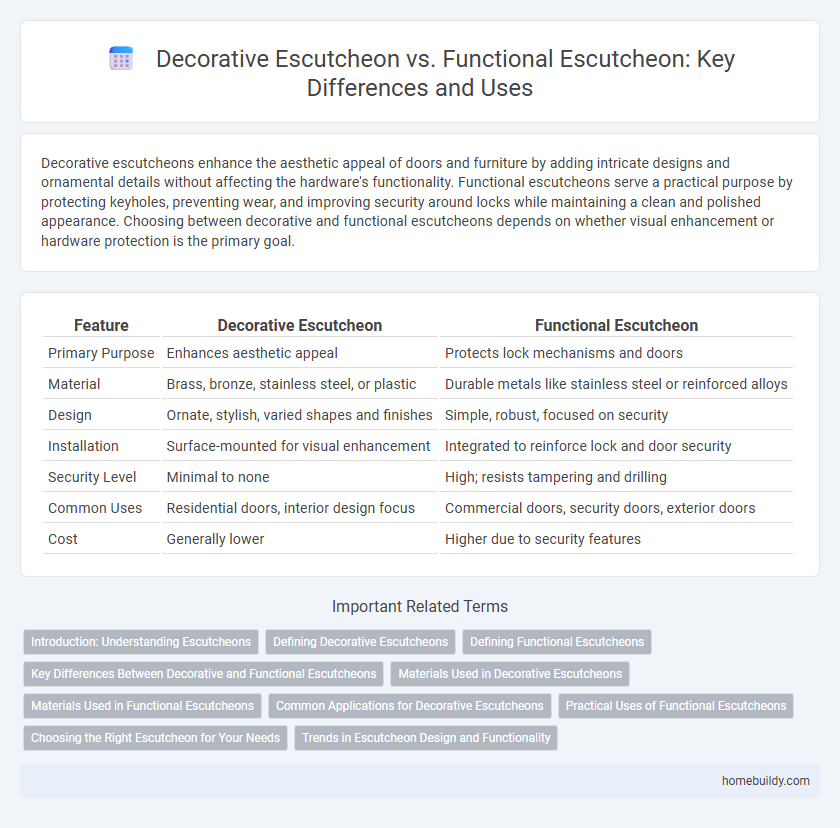Decorative escutcheons enhance the aesthetic appeal of doors and furniture by adding intricate designs and ornamental details without affecting the hardware's functionality. Functional escutcheons serve a practical purpose by protecting keyholes, preventing wear, and improving security around locks while maintaining a clean and polished appearance. Choosing between decorative and functional escutcheons depends on whether visual enhancement or hardware protection is the primary goal.
Table of Comparison
| Feature | Decorative Escutcheon | Functional Escutcheon |
|---|---|---|
| Primary Purpose | Enhances aesthetic appeal | Protects lock mechanisms and doors |
| Material | Brass, bronze, stainless steel, or plastic | Durable metals like stainless steel or reinforced alloys |
| Design | Ornate, stylish, varied shapes and finishes | Simple, robust, focused on security |
| Installation | Surface-mounted for visual enhancement | Integrated to reinforce lock and door security |
| Security Level | Minimal to none | High; resists tampering and drilling |
| Common Uses | Residential doors, interior design focus | Commercial doors, security doors, exterior doors |
| Cost | Generally lower | Higher due to security features |
Introduction: Understanding Escutcheons
Escutcheons serve as protective and decorative plates surrounding keyholes or door handles, with decorative escutcheons primarily enhancing aesthetic appeal through intricate designs and materials such as brass, bronze, or stainless steel. Functional escutcheons focus on security and durability, often incorporating features like reinforced shields, weather-resistant coatings, and anti-tamper mechanisms to safeguard locks and door integrity. Understanding the difference between decorative and functional escutcheons helps in selecting the appropriate style that balances visual impact with security needs.
Defining Decorative Escutcheons
Decorative escutcheons serve as ornamental plates surrounding keyholes or door handles, enhancing aesthetic appeal while concealing hardware. Unlike functional escutcheons, which primarily protect the door surface from wear or provide security, decorative escutcheons emphasize design elements, often crafted from materials such as brass, bronze, or stainless steel with intricate patterns or finishes. These decorative components contribute to interior design by complementing architectural styles and adding visual interest to doors and furniture.
Defining Functional Escutcheons
Functional escutcheons serve as protective plates surrounding keyholes, door handles, or locks, preventing wear and damage to the door surface while enhancing security. Unlike decorative escutcheons, which primarily focus on aesthetic appeal with intricate designs, functional escutcheons prioritize durability and practical utility, often made from robust materials like brass, stainless steel, or zinc alloy. These escutcheons also help in concealing the keyhole mechanism and can incorporate features such as anti-drill plates or reinforced edges to bolster door protection.
Key Differences Between Decorative and Functional Escutcheons
Decorative escutcheons primarily serve an aesthetic purpose, enhancing the visual appeal of doors or furniture by covering keyholes or hardware with ornate designs. Functional escutcheons are designed to provide security and protection, often incorporating features like keyhole covers or reinforcement plates to prevent tampering and wear. Key differences include the emphasis on appearance in decorative escutcheons versus durability and security in functional escutcheons, impacting material choice and installation methods.
Materials Used in Decorative Escutcheons
Decorative escutcheons are often crafted from brass, bronze, or stainless steel to combine durability with aesthetic appeal, while materials like wood and ceramic add unique textures and finishes. These materials not only enhance the visual impact of doors and furniture, but also resist corrosion and wear, ensuring long-lasting ornamentation. Compared to functional escutcheons made primarily for protection and security, decorative ones emphasize material choice to complement interior design themes and color schemes.
Materials Used in Functional Escutcheons
Functional escutcheons commonly use durable materials such as stainless steel, brass, and bronze to provide protection and longevity. These metals resist corrosion and wear, ensuring the escutcheon maintains its structural integrity in high-traffic or outdoor environments. Polycarbonate and other robust plastics also serve in functional escutcheons for lightweight yet impact-resistant applications.
Common Applications for Decorative Escutcheons
Decorative escutcheons are commonly used to enhance the aesthetic appeal of doors, furniture, and cabinetry by adding intricate designs and complementing hardware finishes. These escutcheons often serve as ornamental plates around keyholes or handles, providing a polished and cohesive look in interior design. Popular applications include Victorian-style doors, antique furniture restoration, and modern home decor where the visual impact of hardware is emphasized.
Practical Uses of Functional Escutcheons
Functional escutcheons serve primarily to protect keyholes and lock mechanisms from dust, dirt, and tampering, enhancing security and durability in doors and furniture. They also help to prevent wear around the lock area, preserving the structural integrity of the surface over time. By providing a precise fit around locks, functional escutcheons facilitate smooth key operation while maintaining an aesthetic balance.
Choosing the Right Escutcheon for Your Needs
Choosing the right escutcheon depends on whether the focus is decorative or functional: decorative escutcheons enhance aesthetic appeal with intricate designs and customizable finishes, making them ideal for traditional or modern interiors. Functional escutcheons provide security by covering keyholes or locks, often made from durable materials like brass or stainless steel to resist tampering and wear. Assessing the balance between style and protection ensures the selected escutcheon complements your door hardware while meeting practical needs.
Trends in Escutcheon Design and Functionality
Decorative escutcheons emphasize intricate patterns and varied materials such as brass, bronze, and stainless steel, reflecting current trends towards personalized and vintage-inspired hardware. Functional escutcheons prioritize security features like reinforced backing plates and tamper-resistant designs, aiding in enhanced door strength and lock protection. Modern escutcheon trends blend aesthetic appeal with practical functionality, catering to both residential and commercial demands.
decorative escutcheon vs functional escutcheon Infographic

 homebuildy.com
homebuildy.com